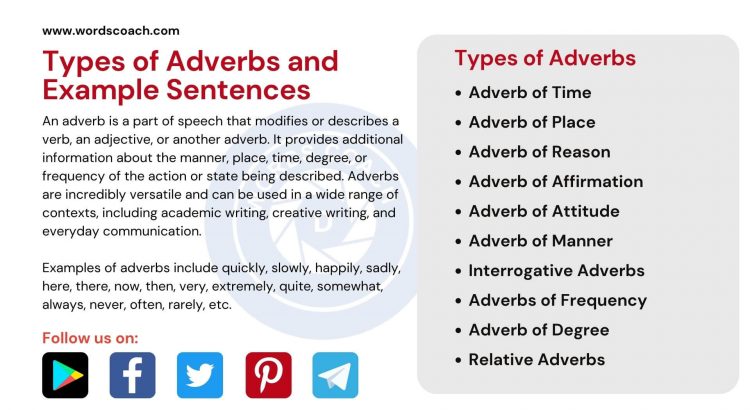An adverb is a part of speech that modifies or describes a verb, an adjective, or another adverb. It provides additional information about the manner, place, time, degree, or frequency of the action or state being described. Adverbs are incredibly versatile and can be used in a wide range of contexts, including academic writing, creative writing, and everyday communication.
Examples of adverbs include quickly, slowly, happily, sadly, here, there, now, then, very, extremely, quite, somewhat, always, never, often, rarely, etc.
Read: 100+ Examples of Adverbs Sentences in English
Adverbs Exercise
10 Types of Adverbs
1. Adverb of Time
These adverbs describe the time of an action or state.
For example, now, then, soon, yesterday, etc.
2. Adverb of Place
These adverbs describe the location of an action or state.
For example, here, there, inside, outside, etc.
3. Adverb of Reason
Adverbs of reason are adverbs that express the reason or cause for an action or situation. They provide additional information about why something happened or why someone did something. Adverbs of reason are used to explain the motivation or justification for an action, and they can be used in both spoken and written language.
Examples of adverbs of reason include therefore, consequently, thus, hence, so, etc.
4. Adverb of Affirmation
Adverbs of affirmation are adverbs that indicate agreement or confirmation with a statement. They are used to confirm or affirm the truthfulness or accuracy of a statement. Adverbs of affirmation are often used in conversation and formal writing to express agreement or to show support for an idea.
Examples of adverbs of affirmation include certainly, definitely, absolutely, surely, etc.
5. Adverb of Attitude
Adverbs of attitude, also known as adverbs of manner, are a type of adverb that describes how someone feels or thinks about an action or situation. They provide additional information about the attitude, opinion, or emotion of the speaker or writer. Adverbs of attitude can be used to convey a wide range of emotions, including happiness, sadness, anger, excitement, fear, surprise, etc.
Examples of adverbs of attitude include happily, sadly, angrily, excitedly, fearfully, surprisingly, etc.
6. Adverb of Manner
These adverbs describe the way in which an action is performed.
For example, quickly, slowly, happily, sadly, etc.
7. Interrogative Adverbs
Interrogative adverbs are adverbs that are used to form questions. They are used to ask about the manner, place, time, reason, or degree of the action or state being described.
8. Adverbs of Frequency
These adverbs describe how often an action or state occurs.
For example, always, never, often, rarely, etc.
9. Adverb of Degree
These adverbs describe the intensity or extent of an action or state.
For example, very, extremely, quite, somewhat, etc.
10. Relative Adverbs
Relative adverbs are adverbs that introduce relative clauses and connect them to the main clause. They are used to describe the time, place, or reason of the action or state being described.
Functions of Adverbs:
Adverbs perform several functions in a sentence. Here are some of the most common ones:
- Modify verbs: Adverbs modify verbs and describe how the action is performed. For example, “She danced gracefully.”
- Modify adjectives: Adverbs modify adjectives and describe the degree to which something possesses a certain quality. For example, “The movie was extremely boring.”
- Modify other adverbs: Adverbs modify other adverbs and describe the degree to which the action is performed. For example, “He spoke very softly.”
- Introduce information: Adverbs can be used to introduce information in a sentence. For example, “Interestingly, he had never been to New York before.”
Using Adverbs Effectively:
Using adverbs effectively can enhance the clarity and impact of your writing. Here are some tips to help you use adverbs effectively:
- Choose adverbs carefully: Use adverbs that accurately describe the action or state being described. Avoid using adverbs that are vague or overused, such as “very” or “really.”
- Use adverbs sparingly: While adverbs can add meaning to a sentence, using too many of them can make your writing sound clunky and repetitive. Use adverbs sparingly and only when necessary.
- Place adverbs correctly: Adverbs should be placed as close as possible to the word they are modifying. For example, “She ran quickly” sounds better than “She quickly ran.”
- Use adverbs to vary sentence structure: Using adverbs can help you vary the structure of your sentences and make your writing more interesting to read.
Adverbs are a crucial part of the English language, and they play a vital role in conveying a message in a sentence. By understanding the different types of adverbs, their functions, and how to use them effectively, you can improve the clarity and impact of your writing.
Download Words Coach: English Grammar

